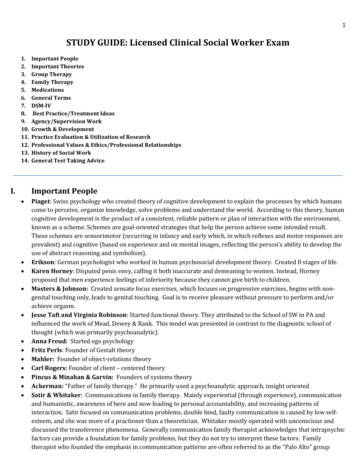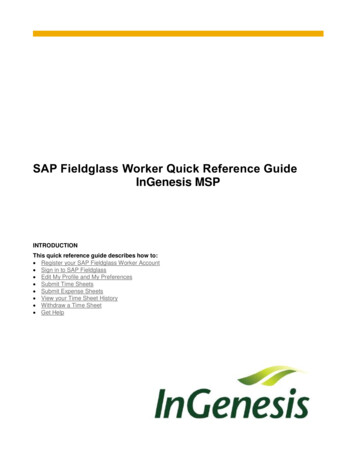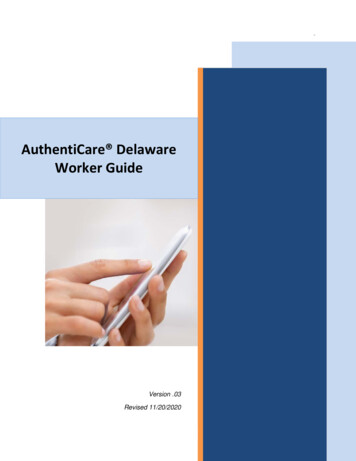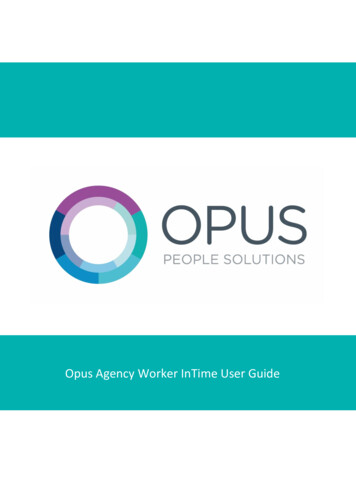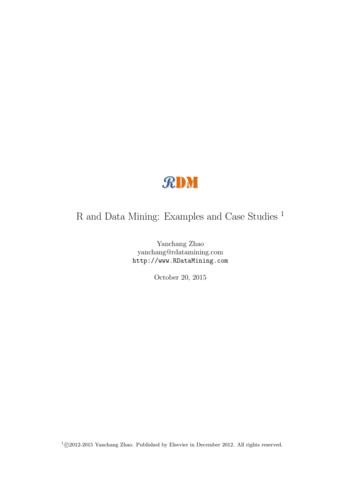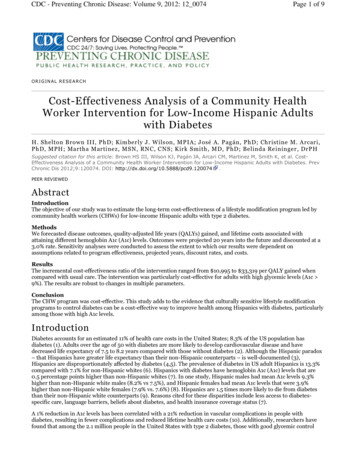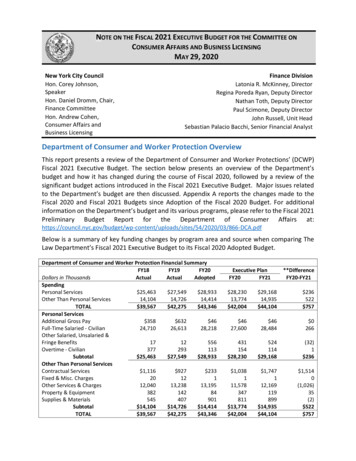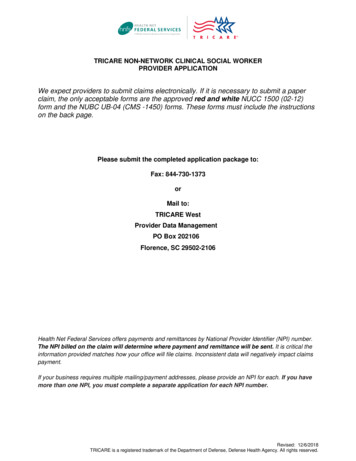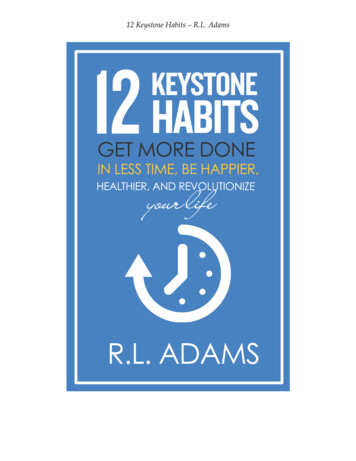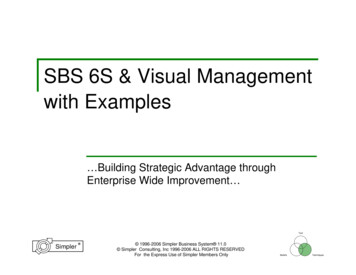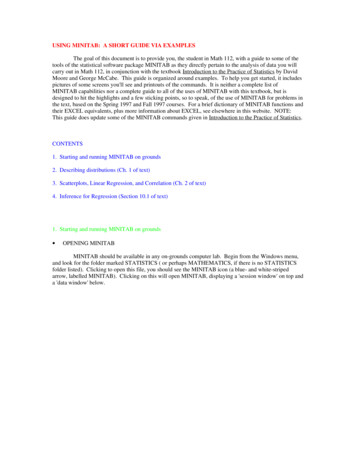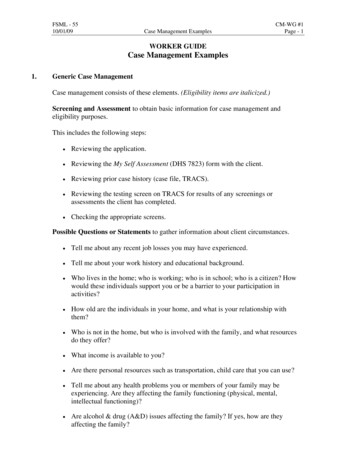
Transcription
FSML - 5510/01/09Case Management ExamplesCM-WG #1Page - 1WORKER GUIDECase Management Examples1.Generic Case ManagementCase management consists of these elements. (Eligibility items are italicized.)Screening and Assessment to obtain basic information for case management andeligibility purposes.This includes the following steps: Reviewing the application. Reviewing the My Self Assessment (DHS 7823) form with the client. Reviewing prior case history (case file, TRACS). Reviewing the testing screen on TRACS for results of any screenings orassessments the client has completed. Checking the appropriate screens.Possible Questions or Statements to gather information about client circumstances. Tell me about any recent job losses you may have experienced. Tell me about your work history and educational background. Who lives in the home; who is working; who is in school; who is a citizen? Howwould these individuals support you or be a barrier to your participation inactivities? How old are the individuals in your home, and what is your relationship withthem? Who is not in the home, but who is involved with the family, and what resourcesdo they offer? What income is available to you? Are there personal resources such as transportation, child care that you can use? Tell me about any health problems you or members of your family may beexperiencing. Are they affecting the family functioning (physical, mental,intellectual functioning)? Are alcohol & drug (A&D) issues affecting the family? If yes, how are theyaffecting the family?
CM-WG #1Page - 2 ) Case Management ExamplesFSML - 5510/01/09Are there concerns about safety for any member of the family? Tell me about that.SEE FOCAL POINT 9. BELOW IN THIS CHAPTER FOR MORE INFORMATION ONDOMESTIC VIOLENCE QUESTIONS.Are there other organizations with which you are involved? If so, what are theseorganizations requiring you to do? How will these plans impact your goals?Remember: the decision maker is the client.This may be a good opportunity to discuss release of information issues with the clientand have them sign the Authorization for Use and Disclosure of Information (DHS 2099)if they agree.Staffing is consulting or meeting with partners regarding clients’ service needs to assistin making joint plans. Before inviting partners or sharing information, obtain the clientsconsent. Staffing could mean: Contacting community partners with whom the client is involved, or may beinvolved with in the future, by phone to advise them of DHS/JOBS activities andto determine the need for joint planning; Arranging a formal meeting of all partners to staff the client and develop a jointfamily plan (the client might be invited to participate); Having an in-branch staffing on a family to problem solve and develop strategies; Consider staffing the family with any branch or local staffing teams to access awide range of services; Evaluating the client’s progress toward achieving the case plan goals.Brokering is guiding clients to appropriate community resources and doing followup todetermine effectiveness.This includes: Identifying and coordinating with partners the client is currently working with; Coaching clients in determining what community resources are appropriate tomeet their needs; Coaching clients in how to effectively access resources; Offering referral information; Doing followup to ensure that the client has connected with the agency/resources/he has been referred to; Assisting client in contacting resources and obtaining help from them, if needed;
FSML - 5510/01/09Case Management Examples Getting feedback from clients on effectiveness of brokered resource; Advocating with partners in behalf of the client.CM-WG #1Page - 3Resources are used or developed to meet client needs.This means: Being aware of all community resources that clients commonly use; Knowing where to obtain information on resources for clients with specializedneeds; Being aware of and using Central Office resources as needed; Alerting others in the branch/district of the need for new resources to meet newlydiscovered needs of clients.Development of Plan Mutually develop the plan with the client for the family and individuals within thefamily based on the Assessment, Staffing, Brokering and Resources. Determine the long-term (usually employment) and short-term goals (intermediatesteps for achieving the long-term goal). The employment goal is based on the client’s skills, job history and abilities. Identify activities to address the short-term goals. Prioritize the accomplishment of activities, if needed. Selected activities will include JOBS components and community resources. Establish time frames for beginning and completing the activity. Determine what resources the client, agency and partners can use to support theactivity. Outline how the plan will be coordinated with partner agencies. Be clear about the case manager’s role in the plan. Establish dates for reviewing progress and the method of contact between the casemanager and client. Update the plan as needed.
CM-WG #1Page - 42.Case Management ExamplesFSML - 5510/01/09Determining the Appropriate Focal Point of Case ManagementKeep in mind that family members may need more than one focal point of casemanagement.WORK STATUSReady to workIdentifiers: Good recent work history. Job losses are not client caused. There areno family or medical problems needing resolution. There are no issues that wouldinterfere with employment. Any issues that need to be resolved can be done in offwork hours.Almost ready to workIdentifiers: No recent job history or job losses that may be client caused. Medicalproblems exist that need to be dealt with prior to employment. There are familyproblems that cannot be dealt with in off-work hours.Working: Retention/Wage EnhancementIdentifiers: Client begins job, but has issues they are still working on. Includesclients moving to employment after TANF, clients in the Post-TANF Program,Refugee benefits or Pre-TANF Program ends. Client is working part time, andneeds help finding full-time employment. Client wants to get a better paying job.Client needs skill building training or education to promote at current job or get abetter job.Child CareIdentifiers: Clients who are working or in JOBS activities, who need care forchildren under 13 or children under age 18 with special needs.TEENSTeen ParentIdentifiers: Parents who are age 19 or younger.Teens (nonpregnant) on OHP or OHP/FS not living with parents/relativesIdentifiers: Teen lives with friends, is homeless or is living on their own.
FSML - 5510/01/09Case Management ExamplesCM-WG #1Page - 5FAMILY ISSUESDomestic violence issueIdentifiers: A response to the application item #5 or #6 indicating domesticviolence. This could also be indicated on the Cooperating with Child SupportEnforcement and Pursuing Third Party Resources (DHS 428A), DCS good causeform and DHS 7823. Client may self-identify as a victim of domestic violence.The case manager observes or becomes aware of hypervigilance; explanation ofinjuries inconsistent with type/location of injury; substance abuse; frequentheadaches; multiple injuries; gastrointestinal problems; eating and sleepingdisorders; depression/suicidal ideation/high anxiety; sexual assault/rape.Client comes to appointments with injuries. Comes to appointments late, needs toleave early, is secretive about home life. There is frequent absenteeism due tomedical problems or concerns about children. Client is excessively emotional,tearful, angry, depressed, nervous or confused. Client has low energy, fatigue andhas trouble making decisions. Does not feel confident making any big decisionswithout partner, and will not make appointments without partner. Partner showsup frequently at client’s JOBS activity site.A&D issuesIdentifiers: Client always blames others for the problems in his/her life.Questionable job losses. Others in family are alcoholics or drug abusers. Joblosses have occurred due to excessive absence. There is pattern of accidents onthe job. Client has had DUIs. There are observable mood swings, dilated pupils,needle marks, the smell of alcohol, hyperactivity, difficulty staying on track ordramatic attention getting. The client has short-term memory loss and/orblackouts. The client may have an infectious disease such as TB, HIV, STDs,urinary tract infections, pneumococcal and other pneumonias, hepatitis B and Cand other vaccine-preventable diseases.Housing issuesIdentifiers: A response on the application in the Emergent Need section regardingneeding a place to live, monthly rent and utility payments being more thanmonthly income or responses that indicate a pending eviction or utility shut-offnotice may indicate a need for support around housing issues. Housing issues mayalso come up during other client contacts, including the screening process usingthe DHS 7823; case management/JOBS interviews; conciliation appointments; aswell as appointments with contractors or other community partners.Health issues (Physical Disabilities, Mental Health, Intellectual Functioning)Physical Health Identifiers: Clients who state they cannot work and/or offer adoctor’s statement to that effect. Clients with observable medical problems.
CM-WG #1Page - 6Case Management ExamplesFSML - 5510/01/09Mental Health Identifiers: Client’s affect is inconsistent with the situation.Frequent visits to hospital emergency rooms. Appearance, attire and hygiene areless than socially acceptable. Client seems disorganized, confused or sleepsexcessively. Chronic lack of follow-through and inability to get along with others.Pattern of noncompliance with case plan activities.Intellectual Functioning Disabilities Identifiers:Learning disability: Client has been in special classes. Reversesletters/figures when filling out agency forms. Low level of literacy asobserved on application.Marginal intelligence: Client has been in special classes. Client hasfrequent job losses which may be due to being too slow. Client hasdifficulty with abstract thinking.Pregnant women/women with infantsIdentifiers: Self identification.Youth/child issues (juvenile justice, education, abuse/neglect)Identifiers: The family is involved with Child Welfare and/or the juvenile court.The child(ren) has poor grades, behavior problems at school, is in special classesor is suspended from school. The parents are called to the school frequently todeal with the child’s problems. Observable abuse or neglect. The family isreceiving treatment/counseling from a community mental health or child welfareagency.Children Living with Adults Who Are Not Receiving Cash BenefitsIdentifiers: Relatives (non-needy caretaker relatives) raising their grandchildren,nieces and nephews or cousins. Families in which one or more of the adults arenoncitizens.Noncustodial ParentIdentifiers: As identified by DCS, custodial parent or relatives of children. Teengirl living with a male.3.Work Status Focal Point; Ready to WorkPrinciple-Based DecisionWork is better than welfare.
FSML - 5510/01/09Case Management ExamplesCM-WG #1Page - 7) SEE WORK STATUS FOCUS POINT; CHILD CARE, IN THIS WORKER GUIDE(CM WG1.6).Assessment Review the Application for Services (DHS 415F). Review the My Self Assessment (DHS 7823) form. Identify what support services the client needs to do job search and becomeemployed. Explain tax credits (EIC, and others). Evaluate (and reevaluate) suitability of client’s job search choices given the jobmarket and the client’s skills. Explore transportation options including carpooling. Explore child care options. Explain transitional benefits to support continued employment.Possible Questions What type of work are you interested in seeking? Is it possible to obtain that type of job within commuting distance? What are your skills? What support do you need to become employed? Do you feel ready to work? Are there any family problems? If so, can they be resolved outside of work or jobsearch hours? Is there anything that would interfere with your going to work, or make it difficultto work? Do you need clothing for job interviews?Staffing Consult with staff in JOBS program. Possibly contact employers to follow up on client interviews.
CM-WG #1Page - 8Case Management ExamplesFSML - 5510/01/09Brokering Other partners may include the Employment Department, WIA, temporaryagencies, Dislocated Worker programs.Resources Local: branch resource room. District: CRC. Central Office: information resource person.Development of Plan Determine the employment goal. Job search will be the primary activity. Other JOBS activities such as Life Skills may be useful. Identify steps to secure adequate transportation, child care, and back-uparrangements. Explore carpooling. Identify what support payments will be needed: transportation, child care, etc. Establish time frames for review of job search. Identify steps to resolve issues that might hinder employment.Tools Job Search Verification (DHS 475), Employment Development Plan (EDP)(DHS 7831), Personal Development Plan (PDP) (DHS 7832), or TRACS PersonalDevelopment Plan. EIC brochures.Legal ConsiderationsIf the client does not have a driver’s license, but does drive for doing job search,explore ways of helping the client get a driver’s license or explore alternativemeans of transportation.If the client has legal problems such as the need to do community service, fines,or is on probation, these will need to be taken into consideration in planning thejob search.
FSML - 5510/01/09Case Management ExamplesCM-WG #1Page - 9Ethical boundaries/cautionsClients who have recovered from A&D problems must not be referred to jobsproviding access to alcohol or drugs.Narrative/Data EntryCoding for CMS:Work status.Coding for TRACS: Enter PE, other activity codes and attendance on TRACS.Coding for FSMIS:Work status.Narrate:Employment goal, date of case plan, review dates,arrangements for transportation and child care, supportservice payments, progress towards goals.EligibilitySupport services payments may be issued during the Pre-TANF Program prior tofinal determination of eligibility.Principle-Based OutcomeClients become employed as quickly as possible.4.Work Status Focal Point; Almost Ready to WorkPrinciple-Based DecisionWork is better than welfare. Some clients need employment preparation activitiesand/or resolution of personal/family issues in addition to, or before seekingemployment.Assessment Review the My Self Assessment (DHS 7823). Identify what support services the client needs to do job search and becomeemployed. Consider contacting previous employers to determine basis for the client’s joblosses. Explain tax credits (EIC and others). Explore transportation and child care options.
CM-WG #1Page - 10Case Management ExamplesFSML - 5510/01/09Possible questions What type of work are you looking for? What are your skills? What caused past job losses? What do you think you could do to solve the problems that caused the job losses? What support do you need to become employed? Are there family issues that need attention so that you can keep your job? How do you plan to get to work?Staffing It is important to coordinate planning closely with staff in JOBS program.Brokering Partners may include a variety of community resources/partners.Resources Local: branch resource room. Central Office: information resource person.Development of Plan Determine the employment goal. Job search will be an activity, if appropriate, based on the results of a labor markettest. Determine what other goals need to be established to remove barriers toemployment. Select activities to deal with these barriers from JOBS components and communityresources. (GED class, work experience, JOBS Plus, vocational training, LifeSkills, etc.) Identify what support payments will be needed: transportation, child care, etc. Establish time frames for review of quality of job search and progress towardsresolution of other issues.
FSML - 5510/01/09Case Management ExamplesCM-WG #1Page - 11Tools Job Search Verification (DHS 475), Employment Development Plan (EDP)(DHS 7831), Personal Development Plan (PDP) (DHS 7832), or TRACS PersonalDevelopment Plan. EIC brochures.Legal ConsiderationsSame as for Ready-to-Work.Ethical boundaries/cautionsSame as for Ready-to-Work.Narrative/Data EntryCoding on CMS:Work status.Coding on TRACS:Enter activities on TRACS, update attendance.Coding on FSMIS:Work status.Narrate:Arrangements for transportation and child care, supportservice payments, progress towards goals.Principle-Based OutcomeClients, who have received job preparation services and who have resolvedpersonal/family issues become employed as quickly as possible.5.Work Status Focal Point; Retention and Wage EnhancementPrinciple-Based DecisionWorking clients will remain employed at the same job or will obtain a betterpaying job.Assessment Determine if the client has any issues that need to be resolved in order to keep thejob. Determine if the employer has classes/training available for skill building. Determine what type of skill enhancement might lead to a better paying job.
CM-WG #1Page - 12Case Management ExamplesFSML - 5510/01/09 If the client has domestic violence issues, determine if the client would like tomake a safety plan regarding employment. Explain transition services and available retention activities.Possible questions How are your child care arrangements working out now that you are employed? Are you able to get to work okay? How are you getting along on the job? What has your employer said to you about how you are doing on the job? How are your children reacting to your working? What skills did your employer say you would have to have to promote? Would you be willing to take classes at night to gain skills?Staffing Could include the current employer. May include community partner staff.Brokering The community college’s financial aid office may be able to help the client obtainfunds for classes.Resources Local: Community college. Central Office: Information resource person. If the client participated in JOBS Plus, the client will have an educational accountthat can be used to fund further skill training.Development of Plan Identify new employment goal. Identify skill and include skill enhancing activities.Narrative/data entryCoding on TRACS:
FSML - 5510/01/09Case Management Examples CM-WG #1Page - 13For clients who become employed while in the JOBS Program:- TRA.- Use one or more retention codes: RT, BR. For any employed client:- Use the appropriate specific TRACS activity code when one exists. Forexample: JS, SL, MH, PT, DA, etc.Eligibility Clients are eligible for JOBS services for retention and wage enhancement aftertheir TANF or Pre-TANF Program benefits close due to employment. Employed FS, ERDC, and OHP clients can receive retention and wageenhancement services even if they did not become employed while in the JOBSprogram.)FOR MORE INFORMATION, SEE RULE 461-190-0211.Principle-Based OutcomeEmployed clients who receive services to help them retain their first job increasetheir income through working more hours, promoting, or getting a better job.6.Work Status Focal Point; Child CarePrinciple-Based DecisionWhen clients are working or participating in the JOBS program, their children arein safe, stable, and dependable child care that supports the child’s development.Clients and child care providers understand the payment system. Clientsunderstand the need to pay the provider the copay, and providers are paidpromptly.Assessment View the development of the child care plan as an integral part of the client’s selfsufficiency plan for which the client and the case manager share responsibility. Coach the client on how to locate and select a quality child care provider using the“Four Steps to Select Your Child Care Provider” in the Parent Guide to ChildCare (DHS 7478). Offer the client the local Child Care Resource and Referralphone number, and review the Provider
FSML - 55 CM-WG #1 10/01/09 Case Management Examples Page - 3 Getting feedback from clients on effectiveness of brokered resource; Advocating with partners in behalf of the client. Resources are used or developed to meet client needs. This means: Being aware of all community resources that clients commonly use; Knowing where to obtain information on resources for clients with .File Size: 2MB
